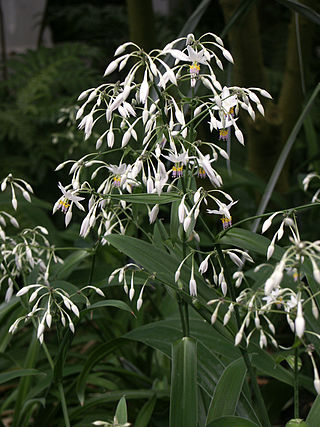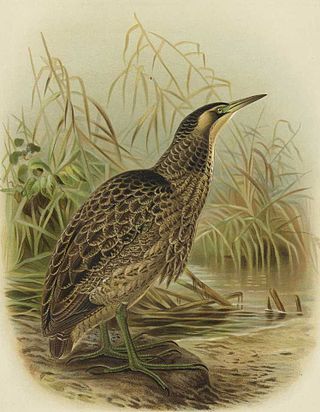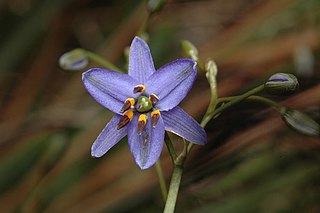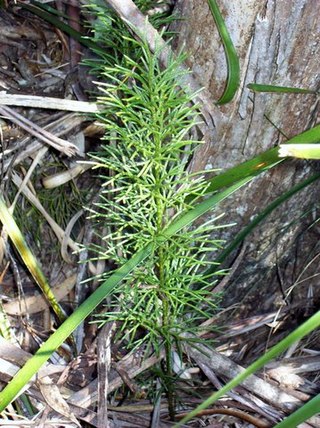
Brisbane Water National Park is a national park on the Central Coast of New South Wales, Australia. The national park is situated 70 kilometres (43 mi) north of Sydney and 12 kilometres (7.5 mi) southwest of Gosford. It consists the Brisbane Water and Mooney Mooney Creek waterways.

Southwest National Park is an Australian national park located in the south-west of Tasmania, bounded by the Franklin-Gordon Wild Rivers National Park to the north and the Hartz Mountains National Park to the east. It is a part of a chain of national parks and state reserves that make up the Tasmanian Wilderness World Heritage Area. Covering an area of 6,183 km2 (2,387 sq mi), it is Tasmania's largest national park.

Nothofagus, also known as the southern beeches, is a genus of 43 species of trees and shrubs native to the Southern Hemisphere in southern South America and east and southeast Australia, New Zealand, New Guinea, and New Caledonia. The species are ecological dominants in many temperate forests in these regions. Some species are reportedly naturalised in Germany and Great Britain. The genus has a rich fossil record of leaves, cupules, and pollen, with fossils extending into the late Cretaceous period and occurring in Australia, New Zealand, Antarctica, and South America.

Arthropodium is a genus of herbaceous perennial plants in the subfamily Lomandroideae of the family Asparagaceae. Members of this genus are native to Australia, New Zealand, New Caledonia, and Madagascar.

Centrolepis is a genus of small herbaceous plants in the family Restionaceae known as thorn grass scales, with about 25 species native to Australia, New Zealand, New Guinea, and south-east Asia as far north as Hainan Dao. APG III system classifies this genus in the Centrolepidaceae family.

The Australasian bittern, also known as the brown bittern or matuku hūrepo, and also nicknamed the "bunyip bird", is a large bird in the heron family Ardeidae. A secretive bird with a distinctive booming call, it is more often heard than seen. Australasian bitterns are endangered in both Australia and New Zealand.

Dianella is a genus of about forty species of flowering plants in the monocot family Asphodelaceae, commonly known as flax lilies. Plants in this genus are tufted herbs with more or less linear leaves and bisexual flowers with three sepals more or less similar to three petals and a superior ovary, the fruit a berry. They occur in Africa, South-east Asia, the Pacific Islands, New Zealand and Australia.

Atriplex cinerea, commonly known as grey saltbush, coast saltbush, barilla or truganini, is a plant species in the family Amaranthaceae. It occurs in sheltered coastal areas and around salt lakes in the Australian states of Western Australia, South Australia, Tasmania, Victoria and New South Wales.

Porpolomopsis lewelliniae, commonly known as the mauve splitting wax-cap, is a gilled fungus of the waxcap family found in wet forests of eastern Australia and New Zealand. The small mauve- or lilac-coloured mushrooms are fairly common and appear in moss or leaf litter on the forest floor in autumn, and are biotrophic. The key distinguishing feature is the splitting of the cap dividing down the middle of the individual gills.

Atherosperma moschatum, the southern sassafras or blackheart sassafras, is an evergreen tree native to the cool temperate rainforests of Tasmania, Victoria, and New South Wales in Australia. It is common in the rainforests of Tasmania and Victoria, but more scattered and rare in the higher altitudes of eastern New South Wales. The northernmost area is at Mount Grundy, west of Port Macquarie.

Gahnia is a genus of sedges native to China, Southeast Asia, New Guinea, Australia, New Zealand and a number of Pacific Islands. The common name is due to the toothed margins. It often forms tussocks.

Telopea oreades, commonly known as the Gippsland-, mountain- or Victorian waratah, is a large shrub or small tree in the family Proteaceae. Native to southeastern Australia, it is found in wet sclerophyll forest and rainforest on rich acidic soils high in organic matter. No subspecies are recognised, though a northern isolated population hybridises extensively with the Braidwood waratah (T. mongaensis). Reaching a height of up to 19 metres, T. oreades grows with a single trunk and erect habit. It has dark green leaves with prominent veins that are 11–28 centimetres (4.3–11 in) long and 1.5–6 cm (0.6–2.4 in) wide. The red flower heads, known as inflorescences, appear in late spring. Each is composed of up to 60 individual flowers.

Euchiton is a genus of flowering plants in the family Asteraceae. They are native to Australasia and the Pacific. Some have been introduced far outside their native ranges.

Rhytidiadelphus squarrosus is a species of moss known as springy turf-moss in the United Kingdom, and square goose neck moss in the United States. It is widespread in Eurasia and North America, and has been introduced to the Southern Hemisphere. It has broad ecological tolerances, and is usually found in man-made habitats such as lawns and golf courses. It is most closely related to R. subpinnatus, with which it is often confused.

Gymnoschoenus sphaerocephalus, commonly known as buttongrass, is a species of tussock-forming sedge from southeastern Australia. It forms part of a unique habitat in Tasmania.

Calomnion is a genus of mosses in the family Rhizogoniaceae. They have been reported from Australia, New Zealand, Polynesia, Melanesia, New Guinea, and eastern Indonesia.

Hypocreopsis amplectens is part of the family Hypocreaceae and genus Hypocreopsis, fungi that form stromata on the stems of trees and shrubs. The stromata are orange-brown and consist of radiating, perithecial lobes. This species of Hypocreopsis was only discovered in 1992 in Nyora (Victoria) during a survey of vascular plants.

Carex archeri, known as Archer's sedge, is a species of sedge in the genus Carex, endemic to south-eastern Australia.

Pseudolycopodium is a genus of lycophyte in the family Lycopodiaceae with only one species, Pseudolycopodium densum, known as the bushy clubmoss. In the Pteridophyte Phylogeny Group classification of 2016, the genus is placed in the subfamily Lycopodioideae. Some sources do not recognize the genus, sinking it into Lycopodium. Pseudolycopodium densum is native to Australia, the North Island of New Zealand and New Caledonia. It is a spore-bearing vascular plant and grows up to a metre high. It is found in a wide variety of situations, often in high rainfall areas on sandy soils.
James Stirton was a Scottish physician and one of Scotland's leading experts on cryptogamic botany. His investigations in bryology and lichenology earned him a world-wide reputation.



















